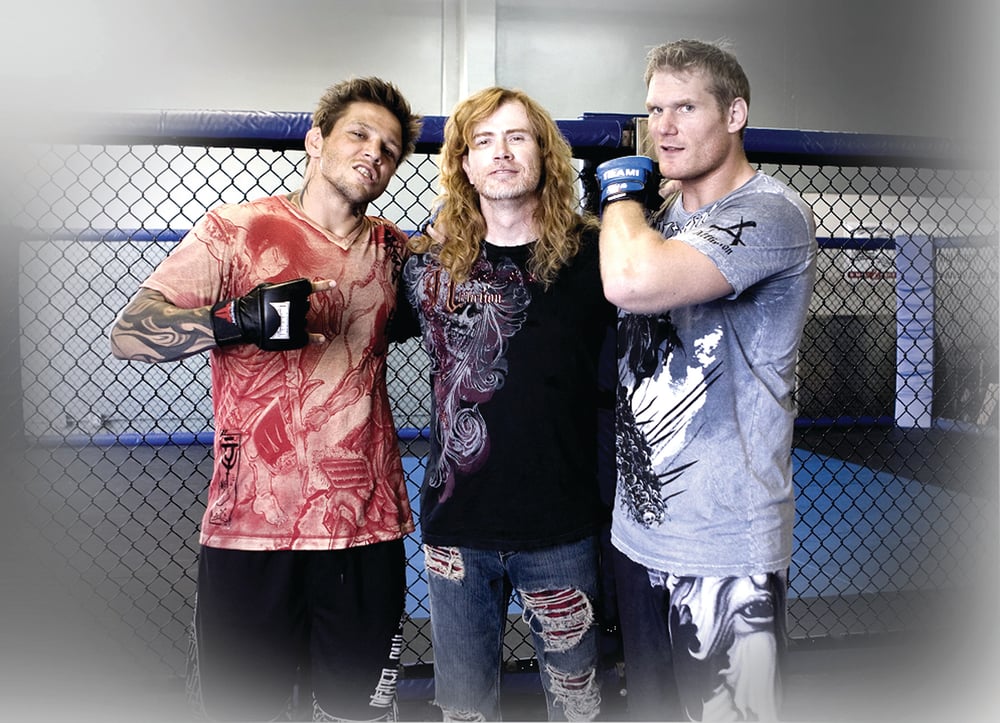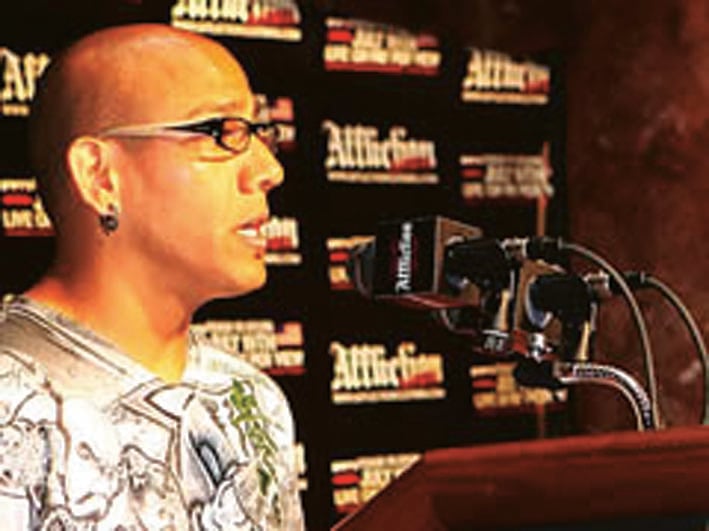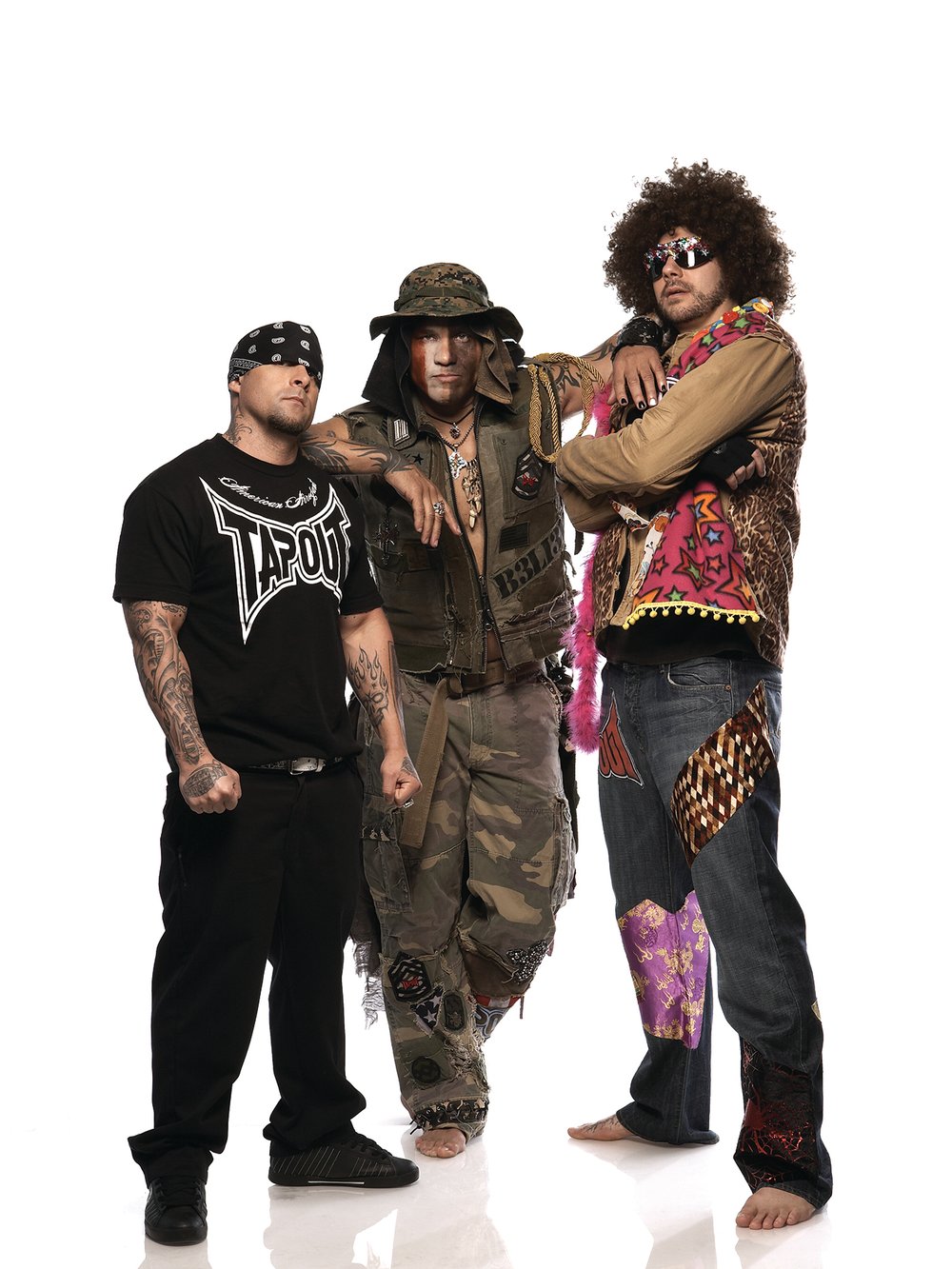
Issue 041
September 2008
Five years ago if you saw someone wearing an MMA brand T-shirt (and believe me, there weren’t many to choose from) it was like spotting someone from your secret society. Nowadays you can purchase some of the leading brand merchandise on the high street as well as from the multitude of excellent retailers, both physical and online, who advertise in these pages.
It’s only natural that with the growth of the sport that the industry around it should grow too, but MMA clothing has become a phenomenon in its own right. With Tapout (arguably the first MMA apparel brand) projecting sales of $100 million for this year, and counter-culture clothing giant Affliction recently holding their own event with some of the biggest name heavyweight fighters in the world, it seems that there has never been a better time to be in the MMA clothing market.
But what makes MMA fashion so different from other sports fashions? Where did it come from? Why has it taken off so quickly? Who are the big players, and where do things go from here?

The Look and Inspiration
Rather unsurprisingly a lot of MMA fashion involves very strong, masculine imagery with skulls, coats of arms, gladiatorial imagery and predatory animals (hawks, lions and so on) featuring heavily. It’s the toughest sport in the world, so why wouldn’t the fashion follow that tough, macho ethos?
Graphics that sprawl the entire front (and sometimes rear) of the shirt are not unusual. But while it’s the norm in MMA, you’d be hard stretched to find the same on the high street outside of the few MMA brands that have shelf space. That suggests MMA,
as enclosed as it is, has unique trends – a localised fashion ecosystem, if you will.
Another function-driven feature of MMA fashion designs is the collar print. Regardless of how good your product is, to sell it’ll need to be seen on the right people. High level MMA fighters earn a substantial portion of their income from clothing sponsorship deals (when was the last time you can remember seeing a UFC main card fighter walk into the cage wearing a plain t-shirt?) and the collar is prime real estate for any sponsor. Why? Because it’s the only branding spot that can be seen when the camera goes close-up on their face.
“A lot of companies are influenced by the skateboarding, BMX and motocross cultures and those designs are carrying over into MMA wear,” says Craig House, owner of Six Deuce Clothing. “For instance, a lot of shirts right now use skulls and Old English writing which are common across the board.”
Similar to skateboarding, MMA fashion both indicates and reflects that MMA is more than a sport but a lifestyle as well.

The Appeal
So why has MMA fashion grown so much and what is the appeal of the MMA fashion brands?
According to Patrick Lally, co-manager of Conflict, a new MMA clothing store in Manchester’s trendy Afflecks Palace, the diversity and individuality of what is on offer is appealing to many. “We’ve had all kinds of people come in because there’s something for everyone. You’ve got your Affliction stuff, which has a rocky, grungy feel, and your Serious Pimp, which is more hip hop. And you don’t have to be into the sport to like the shirts. To the untrained eye Michael Bisping wearing an Encounter shirt could be a model, they don’t necessarily know he’s a fighter.”
FHM recently ran a ten-page fashion shoot in their August issue featuring some of the UFC’s biggest names, including Wanderlei Silva and Quinton Jackson wearing both MMA and mainstream brands. Michael Bisping was even pictured wearing an Encounter T-shirt, a brand that he set up in order to capitalise on the trends in the industry. FHM’s fashion editor Steve Beale explained the reasoning behind the piece. “They are the coolest guys in the world right now. We don’t use male models, so we’re always on the look out for sporting people for photo shoots” “They’re very versatile, these MMA t-shirts,” he said. “I was going to see Iron Maiden and I was like, ‘What the hell am I going to wear?’ I thought, ‘Of course! I’ll wear a Sinister t-shirt!’” Rock concerts aren’t the only places you’ll find MMA shirts floating around though, as Steve can verify. “In terms of expanding, consumers are voracious, particularly that group of young males with high disposable income. I think maybe they’re looking for something new in relation to the other sportswear brands they’ve been wearing. I’m surprised I don’t see more people wearing it. When I go to the football I’ll see a few people wearing Affliction, and one or two people wearing Tapout or something. It’s definitely out there.”
Just like how a football fan will wear his team’s shirt, MMA fans wear the clothes that show the sport they follow. Patrick Lally says, “People are buying the shirts because it makes them feel part of it, and because they feel the brands are exclusive to them.”
“Sinister’s slogan for a long time has always been, ‘What the fighters wear when they’re not fighting’,” states Ed Soares, manager of Anderson Silva and owner of Sinister. “We’re not really trying to go after that Tapout, Sprawl or Warrior Wear market. We’ll have some crossover business, but we really want to incorporate the lifestyle and how we live.” For Ed and Sinister that means more than MMA. It also means the action sports they and the fighters do in their down time – surf, skate and snow. “MMA has its own music, clothing, artwork, style, tattoos,” says Simon Crowther of Fightshop.com. “It’s a subculture that is emerging into the mainstream.”
It’s notable that none of this MMA fashion culture is mirrored in its closest cousin, boxing. What’s more, any brands that are associated with boxing tend to have a more clean cut aesthetic compared to MMA brands like Tapout and One More Round. But then again, boxing gained prominence at a time where there was no consumer culture. It’s only recently, within the last twenty years, that brands have sought to become actively associated with sports and thus create a base of customers from the fans. Whilst boxing is a more established sport it is also an older sport and this is reflected in brands such as Everlast and Lonsdale, who continue to produce sportswear that is worn as street wear as opposed to the opposite in MMA. Some also point to the fact that MMA is perceived as being ‘cool’ and fresh right now, whereas boxing is something your granddad did in the army.

The Big Players
Without doubt the two biggest players in the MMA fashion market right now are Affliction and Tapout.
Tom Atencio, vice-president of Affliction, says part of how they have grown is by not making their brand accessible to everybody, only to a top-tier market. They have their imprint label, Xtreme Couture, as their affordable MMA brand while keeping Affliction a lifestyle brand to aspire to. “Tapout has been around for a long time. Hitman has been around for a long time. But we don’t really compete with them. We’re in a top-tier market, they are in a lower price bracket. It’s a completely different market,” he said.
Interestingly, Tapout are just as dismissive of Affliction, both the biggest fish. In an interview with the Baltimore Sun, co-founder Dan ‘Punkass’ Caldwell stated, “Affliction’s nothing, bro. They’re their own market. That’s fine. Let them do what they’re going [to do]. They’re not us. They don’t do what we do. They can’t do what we do. They’re not going to make gear or clothing like we make clothing. They can’t expand into some of the markets we can
go in.”
The main differences between Tapout and Affliction is that the former claims to be MMA only and the latter is ‘counter culture’. Tapout market themselves as being solely an MMA brand. Caldwell is quoted on brandweek.com as saying “We’ve had people come to us to sponsor drag cars or skaters, but we just don’t do that, we keep all of our money in the sport.”

By contrast Affliction don’t only have MMA fighter signature t-shirts but also boxer signature shirts (Ricky Hatton, Kelly Pavlik), heavy metal musician signature shirts (Ozzy Osbourne, Korn, Suicidal Tendencies) and tattoo artist signature shirts (Kari Barba, Horiyoshi III). This demonstrates that Affliction represents a lifestyle brand heavily entrenched in MMA as opposed to being driven by MMA.
Under the guidance of owner Ed Soares, Sinister has evolved from nightclubs into MMA. Ed says, “Over this next year you’re really going to see the expansion of Sinister because we’ve been focusing on putting our package together and how we’re going to market the brand.” Ed explains that while Sinister is well known in the MMA world he really wants the brand to envelop all kinds of extreme sports as well. Recent designs have seen the brand back this up with an expanded range although their logo shirts remain a fan favourite.
One More Round is Matt Hughes’s clothing line, which not only features some very credible designs but also has its roots based firmly in MMA. Sponsoring fighters such as Kenny Florian, Heath Herring, Dan Henderson and Patrick Cote this ‘young upstart’ is definitely beginning to make it’s presence felt in the market. Check out the feature on pages 68 and 69 to find out more about them.
Cage Fighter (or MMA Authentics as they’re otherwise known) shun some of the more frequent MMA fashion trends, especially with their sponsored fighters line, producing colourful T’s emblazoned with the ‘Cage Fighter’ logo. A shrewd string of sponsorships (including BJ Penn, Chuck Liddell, Forrest Griffin and Roger Huerta) has seen their stock rise in the MMA community. The premium line of Familia Gladitoria however follows more in the line of what we’ve come to expect from the genre.

The UFC Merchandise Deal
Although its reaches go far further than just clothing, the much murmured-about UFC merchandising deal will have an impact on the MMA clothing industry. With a rumoured quarter of a million pounds being taken in merchandise sales at UFC 75 (posters, programmes and T-shirts), as well as the UFC frequently breaking merchandise records at arenas worldwide, it seems only natural that the UFC should attempt to fortify it’s merchandise offering.
After all, there’s a school of thought that says that without the efforts of the UFC in the first place, many of the aforementioned brands would not have a platform upon which to show their product and grow their own businesses. Ironically, it could be argued that without the exposure that the UFC gave to Affliction in their earlier sponsorships of fighters, Affliction would have neither the revenue nor the market presence with MMA to promote their own show.
As an add-on to their regular UFC contracts, it’s been rumoured that fighters will be asked to sign an agreement that would allow the UFC to use their likeness across any kind of apparel you can think of. In return they receive a cut of the profits. However, as it stands, the fighters would be required to sign those rights over for good, unable to opt-out even if they left the company.
As a result, not everyone is thrilled. Robert Joyner says, “In the short term it will only have a slight effect on MMA clothing. The UFC is mainly signing lower-tier guys at this point. Low hanging fruit, if you will.” For the time being Robert says fighters aren’t required to sign anything, and its business as usual.
In the future he speculates that the situation might become less rosy. “I see the UFC going to a closed system, where the only apparel you will be seeing on the fighters is either in-house Zuffa apparel or approved brands that have made deals with Zuffa to be exclusive providers.
“This would sort of be like Reebok being the official apparel company of the NFL and coaches not being able to wear anything else, even a suit, if it isn’t Reebok gear. I think the merchandise deals will be the coin of the realm, part of the cost of entry into the UFC.” Of course nothing is certain yet, but it is a possibility that down the line the UFC may not allow any brand to be worn into the Octagon unless it’s their own.
After all, they’re currently giving clothing brands free advertising. If this were to happen, ultimately it would mean less exposure for the clothing industry and no reason to give fighters huge pay cheques for wearing their brand. On the flip side, the UFC deal would give fighters a constant stream of steady revenue.

The Future
Looking down the line, what could be around the corner for the brands belonging to MMA? Could it be the mainstream? An influx of big money corporations? Robert Joyner muses that a big sporting goods company like Reebok or Nike could branch into MMA but he doesn’t think it would be on a large scale – perhaps only by sponsoring one fighter, a Michael Jordan-type figure. And he suggests that with the barriers of entry into the market being so low, firms with small amounts of capital can still get into the industry. In the same way, it means the fighters can continue to gain from the sport first hand through their companies. Tito Ortiz, Josh Koscheck and Frank Trigg all have their own MMA brands.
Extreme sports such as skateboarding have set the benchmark for a fashion that surpassed its sport and perhaps this is the future of MMA fashion. Joyner, doesn’t see it that way. “I think that might be a case of putting the cart before the horse. MMA brands would have to reach a monumental level of popularity independent of mixed martial arts to raise the sport, which I don’t see happening. The sport is the driver of apparel, not the other way around.”
“Two years down the line I think you will have seen the MMA clothing industry reach a point of ubiquity,” professes Joyner. “It’s already well on its way to that level, with the popularity of brands like Tapout and Affliction, among folks that aren’t even MMA fans.”
With all this expansion, growth and rising sales, how will it impact the most important entity of all: the sport? Logically, all the extra money flowing in can only be a good thing. Fighters will be treated better and fight organisations can build relationships with clothing brands, just like between Tapout and the UFC, which benefit both parties. Fans have already started to reap the rewards of a successful clothing market.
Affliction used revenue from selling their brand to put on one of the most high-profile fight cards in recent times with their ‘Banned’ event. “As MMA grows the lines are going to grow,” says Tom Atencio. “A lot of people are jumping on board right now but over the next few years it will weed itself out. The strong will survive.”

Tapout: The Arrogant American Archetype
Tapout is quite literally the company that started it all. The first true MMA brand is now a company that sells items adorning the curved logo in stores worldwide. ‘Mask’ (Charles Lewis) and ‘Punkass’ (Dan Caldwell) started what is now a giant in the sport in 1994, with Tapout shirts being sold out of the back of Mask’s car at UFC events. From there the group branched onto the Internet, founding the company in November 1997 in a San Bernardino, California, apartment just four years after what would later become known as MMA landed in the US.
Starting with Internet sales only, Tapout grew from $29,000 to $3m in 2005. The company then hooked up with Marc Kreiner, an entrepreneur who is best known for his success promoting and marketing disco records in the 70s (his most well-known act was Chic of ‘Le Freak’ fame – ask your father).
Together they brought in minority investors to make sure that they had the capital to pursue an aggressive marketing strategy of getting their gear on the right people, in the right places. Tapout became an exclusive apparel sponsor for the UFC and WEC. In 2007 the crew signed with a TV channel in the States for a show about finding young fighters to sponsor and develop. As the show runs its second season Tapout have agreed a deal to supply huge US chain Footlocker and begun work on a comic book series based on the three owners.
The brand went from $3m sales in 2005 to $22.5m in 2007 with projections of $100m and $225m for 2008 and 2009 respectively. *










